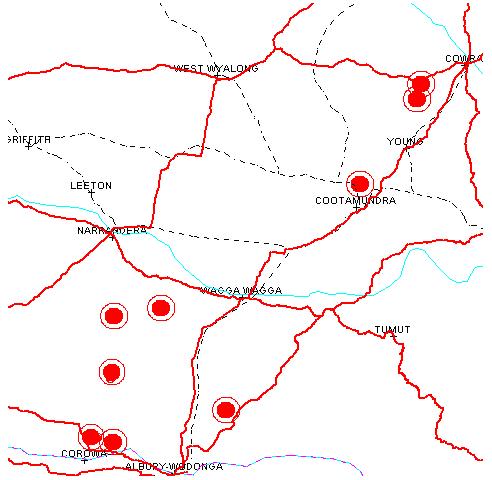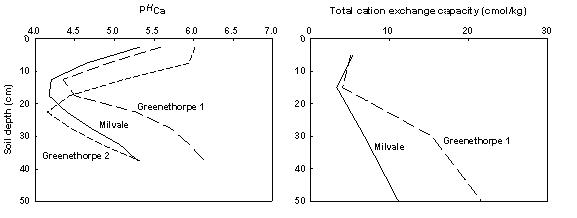Canola and the acid throttle
| Date: 18 Jun 2008

John Angus1, Tony Swan1, John Kirkegaard1, Ashley Beven1,2, Chris Duff3 and Mark Conyers4
1 CSIRO Plant Industry, Canberra
2 Summer student from the University of Melbourne
3Delta Agribusiness, Young
4 E.H. Graham Centre and Agricultural Research Institute, NSW Department of Primary
Industries, Wagga Wagga
Take home message
Canola is the most acid-sensitive of the major crop species grown on the red soils in south-eastern Australia. These soils are normally limed before sowing canola. This practice has corrected surface acidity but values of subsurface (typically 10-20 cm) pHCa< 4.5 are now
common, leading to development of an acid throttle, sandwiched between the limed surface
and the naturally neutral or alkaline subsoil. Is the acid throttle affecting canola growth? On the basis of three experiments in 2007, where we injected lime into acid (pHCa 4.0 – 4.3) subsurface layers, apparently not much. It appears that canola is relatively tolerant to subsurface acidity, possibly because soluble manganese is not present at a toxic concentration.
Introduction
This paper reports progress on NSW experiments in the GRDC Canola Yield Decline project (2006 – 2009). The project is co-ordinated by the E H Graham Centre and has partners from CSIRO, NSW Department of Primary Industries, FarmLink, DPI Victoria and the University of Melbourne. Consultants Tim Condon, Chris Duff and John Sykes provide advice and industry contacts. The project aims to examine the effects on canola productivity of subsoil limitations of high soil strength, sodicity, salinity and acidity. Nine experiments were conducted in southern NSW in 2007. A common treatment was to rip and blow lime or gypsum into the subsoil. The western experiments, focussed on sodicity and salinity were not harvested due to the severe drought (Fig. 1) but the eastern experiments which focussed on compaction and sub-surface acidity provided useful results.
Fig 1. Locations of nine Canola Yield Decline experiments during 2007.
Subsurface acidity
Some acidification is almost unavoidable for productive agricultural systems but the change in soil pH depends on the buffering capacity of the soil. For neutral and alkaline soils with high cation exchange capacity there is little change in pH with normal farming practices. However, the red earth and red brown earth soils of south-eastern Australia have low cation exchange capacity and without lime, the original pH > 6 at the surface has fallen to pH < 4.5. The acid layer becomes deeper with time as cations are leached from progressively deeper layers. Lime is routinely applied to the surface of these soils before growing canola, which is the most acid-sensitive of the major crops. The effect has been to create a layer of low pH sandwiched between the limed surface and the naturally neutral or alkaline subsoil. This layer often has high soil strength because of natural or induced compaction, so that roots may be exposed to both physical and chemical limitations.
As soil pH decreases, the concentration of toxic forms of aluminium (Al3+) and manganese (Mn2+) increase. Research by Sergio Moroni and colleagues at Wagga Wagga showed that canola is particularly sensitive to the soluble bivalent form of manganese, but less sensitive to aluminium. The reaction that produces Mn2+ requires acidity and electrons from organic matter:
MnO2 + 4H+ + 2e- = Mn2+ + 2H2O
Surface lime will not correct subsurface acidity unless huge amounts are applied. Cultivation to mix limed surface soil with an acid subsurface is effective and has previously been shown to increase yield of acid-sensitive wheat (unpublished CSIRO data). In this project we injected lime into the subsurface with the FarmLink ripper-injector. This consists of a Yeoman’s linkage ripper and trailing air-seeder box from which lime is blown down tubes behind each of five tines.
Experiments in 2007
Three experimental sites met our requirement of a limed surface soil above an acid throttle (Fig. 2). At Milvale, a layer from about 10-25 cm has pHCa < 4.5, while at Greenethorpe 1 the layer with pHCa <4.5 was < 5 cm thick. At Greenethorpe 2 the lowest pH was deeper than 20 cm. The difference between Milvale and Greenethorpe 1 in the thickness of the acid throttle is consistent with the differences in cation exchange capacity. Presumably the downward movement of acidity depends on the profile of cation exchange capacity. 
Fig. 2. Profiles of soil pH and cation exchange capacity in autumn 2007.
In autumn 2007, we set up the three experiments, with plots at Milvale and commercial size strips at the two Greenethorpe sites. We injected lime into the subsurface using the FarmLink ripper-injector. The soil was ripped to 25-30 cm, the bottom of the subsurface acid layer, with a tine spacing of 45 cm. The rate of lime application varied between the experiments (Table 1).
The uniformity of the effect of lime injection was measured at Milvale and found to be uneven across the rip-lines, with an increase of pHCa from 4.3 to >6 in the rip lines, but little change between the rips. Despite this variation there was no striping in the crops. We included control treatments of no-ripping, ripping only and ripping with surface lime application. Crops of Tornado canola were sown at the three experiments in early May.
Dry matter was sampled before the crops ran out of water but after the roots had penetrated through the acid layer. There was no growth response to subsurface lime injection at any of the experiments (Table 1). There were even some negative responses to lime injection, possibly because of poor seedling establishment in the rough seedbed left by the ripper. At Greenethorpe 1, ripping alone gave more growth but the effect disappeared when crops ran out of water (data not shown). The level of plant Mn is below the toxic range for canola (>600 mg/kg); the toxic level for Al is unclear.
Table 1. Canola dry matter (t/ha) and concentrations of tissue manganese and aluminium (mg/kg) in relation to subsurface lime application in three experiments in 2007.
|
Location
|
|
DM
|
Mn
|
Al
|
|
(sampling date)
|
|
(t/ha)
|
(mg/kg)
|
(mg/kg)
|
|
Milvale
|
Control
|
1.22
|
154
|
147
|
|
(16/8/2007)
|
Rip (25 cm)
|
1.10
|
112
|
203
|
|
|
Rip (25cm) + lime injected (3.7 t/ha)
|
0.88
|
116
|
248
|
|
|
Rip (25cm) + lime injected (7.5 t/ha)
|
0.92
|
124
|
202
|
|
|
Rip (25cm) + lime broadcast (3.7 t/ha)
|
1.26
|
132
|
189
|
|
|
l.s.d.
|
0.26
|
n.s.
|
92
|
|
|
|
|
|
|
|
Greenethorpe 1
|
Control
|
0.38
|
203
|
688
|
|
(1/8/2007)
|
Rip (25 cm)
|
0.74
|
166
|
542
|
|
|
Rip (25 cm) + lime inject (4 t/ha)
|
0.83
|
153
|
433
|
|
|
l.s.d.
|
0.13
|
n.s.
|
n.s.
|
|
|
|
|
|
|
|
Greenethorpe 2
|
Control
|
4.23
|
|
|
|
(3/10/2007)
|
Rip (25 cm)
|
6.28
|
|
|
|
|
Rip (25 cm + lime inject (4 t/ha)
|
6.35
|
|
|
|
|
Rip (25 cm) + lime broadcast (4 t/ha)
|
6.08
|
|
|
|
|
l.s.d.
|
1.36
|
|
|
Implications
There was no effect of subsurface liming on canola growth. One explanation is that canola roots were able to push through the acid subsurface and reach the neutral subsoil without damage. An alternative explanation is that Mn2+ was not present in the subsurface at a level sufficiently toxic to reduce canola growth. If the second explanation is important, it may be that the reaction that produces Mn2+ did not proceed in the subsurface because there was insufficient reactive MnO2 for reduction and/or insufficient reducing capacity from organic matter. Glasshouse experiments are underway to investigate this further and also investigate the interaction of subsurface acidity and high soil strength.
On the basis of these experiments we conclude that canola does not require liming of an acid subsurface, but of course does require surface liming. While this is reassuring for canola production it is a matter of concern for natural resource management. Profit from the canola-wheat system has paid for liming in mixed farming areas for the past 10-15 years and allowed the re-introduction of acid-sensitive species like lucerne. We don’t know whether other species are as tolerant to acid throttles as canola. Continued development of acid throttles may close off options for future crops and pastures.
Acknowledgements
Thanks to David Davidson, Warwick Hodge and Rob Taylor for providing land and to GRDC for funding.
Contact: John Angus
Ph: 02 6246 5095
Email: john.angus@csiro.au
GRDC project UCS00008
Was this page helpful?
YOUR FEEDBACK
